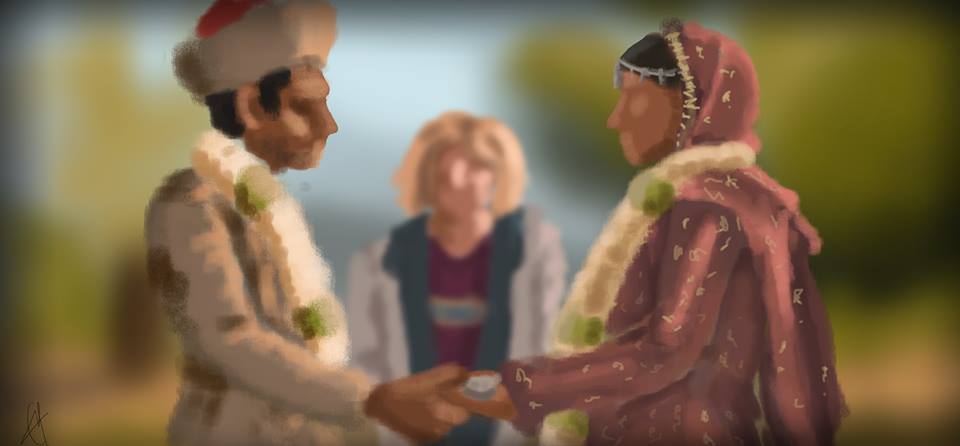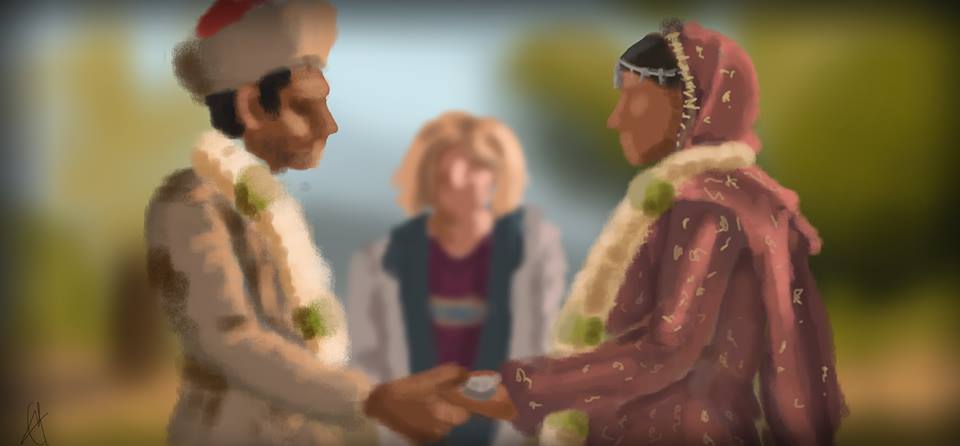|
If you enjoy this essay, why not support us on Patreon and help make this possible? Go join the cool kids at http://www.patreon.com/jameswylder The art for this post is by the amazing Anne-Laure Tuduri, you can see more of her art at: http://liria10.tumblr.com Demons of the Punjab
No one is who we think we are, and most of the time, that’s okay. Most of the time. We can live our lives with the people we love content with a layer of secrets over it. Love is, sometimes knowing not to ask. But those secrets form something deep about us, something important. And it’s hard to think we really know someone till we know those secrets, and maybe we don’t. Demons of the Punjab is a lot of things. It’s a reflection of family secrets, a continuation of the running themes of this series of Doctor Who, a history lesson into an awful and often untouched period in the history of colonialism in India and Pakistan, and a damn fine character study to boot. Yaz gets to take center stage this week, and even more than during Arachnids in the UK, we get to take a delve into who she is as a person. That the episode is framed around the companion making a request of the Doctor is nice, its cute, and the Doc’s reluctance is a fairly nice subtle callback to her past experiences in “Fathers Day” and “Dark Water/Death in Heaven”. In a lot of ways, this is the episode that most feels like our characters have settled in as Team TARDIS. The first five episodes established our new era, and now we get to just fly around and have adventures, which is nice. That it took us so long (episode 6 of a 10 episode season) to get this far is different though, it’s a big change from the traditions of the past. It’s been common to want to get right into blazing into adventures, and there’s been a tried and true format for each re-introduction of the show: you do one episode in the past, present, and future (being in space counts as future) and then after you’ve established all that, you can blaze onto into whatever adventures you want. Here our pacing has been slower, more careful. We’re just now getting out of the wilderness. And what a clearing it is. This episode focuses on death, and how those who survive death deal with it living on into the future. The episode is framed around Yaz’s grandmother, and so we know she lives, but knowing she lives doesn’t take away from any of the tension or drama. We know from the start that she’s carried these memories with her throughout her entire life. We know if things go badly, and they do, that this has been a burden on her. It’s a different way of carrying tension then we’ve been given, and it works. While talking about an episode’s quality isn’t something I’m super interested in (something that lead to some problems with my Tsurunga Conundrum essay) I’m going to note that this is, in my humble opinion, the strongest episode we’ve gotten so far in the Chibnall era of Doctor Who. Indeed, the biggest flaw I can throw at it is we already saw the episode’s big twist about the monsters 7 episodes ago in “Twice Upon a Time” where the malevalent aliens turned out to be actually be kind fellows who were going around to see people before they died. That we just saw this plot not too long ago is…really my only complaint, and in a season where last week we saw one of the most common repeated Doctor Who plots done once again, that’s barely a complaint at all. Demon’s of the Punjab is moving, original, and like nothing we’ve seen before in Doctor who largely. We haven’t had something like the Partition of India on Doctor Who before. The last time we had an episode with the main plot taking place in asia was in the 1960's, with the Abominable Snowman, and it wasn't primarily concerned with the lives of everyday Tibetans. The Thijarians, our “demons”, mirror the Doctor not just in how they mirror the end of Twice Upon a Time, but in how their planet was destroyed, and now they live on trying to be kind after the fact. It’s a nice parallel, though it does make me wonder if we’ll get a reveal the Stenza killed their planet off. But the Thigarians aren’t the real demons, rather, that’s colonialism. This episode is unrelenting in showing the damage caused by the hasty and ill-planned partition of India, and does an amazing job of balancing thing so that no religion or ethnic group is entirely to blame for what happens. The blame falls on the people who were supposed to care for this area, and who let it down, giving excuse for violence and hatred and lust for power to spill over into bloodshed. This is an episode that ends with one of our favorite people being shot and murdered in cold blood. It’s not messing around. As it shouldn’t. The Doctor and friends once again can only watch, letting events unfold as they are supposed to and not interfering. We’ve seen a lot of that this series, but it is a different turn for the show as a whole. The bad guys have gotten away. One smaller parallel is the breaking up of the team into gendered groups, something we’ve seen a few times through the series now. Graham and Ryan get a scene with the groom, while Yaz and the Doctor get one with the bride. The team being split this way allows the Doctor who explore her new role as a woman, and her joy in being in female spaces, but also allows for Graham to show us a kinder form of masculinity. Throughout this series, we’ve seen lots of nasty men. Plenty of examples of men who are so caught up in the petty way they want to see themselves that they miss the reality in front of them. Graham has grown to be a beautiful character, because though he’s flawed, he represents an alternate route of masculinity in the story. You don’t have to be violent and power hungry to be a man. You can be a good man, and be kind, and that’s a message I’m absolutely here for. * * * Let’s take a moment to try and look into our crystal ball at the end of the series, shall we? We’re now six for six on: 1. Villains getting away. 2. Someone having something in their body they don’t want (this time, the Doctor getting visions forced into her). 3. Synthetic/Organic blends (the alien goo in the jar, this time). And we’re NEARLY six for six on things getting teleported in each episode (I can’t recall anything getting teleported in “Arachnids” but let me know if I forgot something in the comments). So I think it’s fair to say that either these are all intentional things being played out for us to notice, building to something in the series finale in episode 10, or these are just weird co-incidences built in from the series being written with a writers room and they mean nothing. So, let’s assume they do mean something. This doesn’t mean they’re going to come together in some carefully woven and intricate plot, but it does mean I think these things are going to play out in the finale in a big way. So, here are the four ways I think the series could go for the finale: 1. The Evil League of Evil Most/Some/All of the baddies we’ve let go during the series come back for the finale. Maybe only in a cameo, but a few of them form a core of badness and the Doctor has to defeat them. This could also JUST mean cameos from the villains, tying things together. Whatever their plot is, it will involve 1. bodily autonomy, 2. synthetic/organic combination, and 3 probably teleporting some how. 2. Consequences Alternately, if they don’t come back, the way they’ve all gotten away screamed intentionality. In this scenario, the plot isn’t so much about every villain who was let go coming back as about putting the Doctor in a position where letting the villain go like she’s done is an option she can’t abide. Here the conflict isn’t direct, it’s an internal emotional one, with the villains being let go building up an internal conflict for the Doctor. 3. Return of the Stenza The Stenza come back, and the focus is simply on them as a villain. If this is the route, I predict a very heavy lean in to the bodily autonomy angle. Maybe the Stenza are teleporting in beings and kidnapping them, using them for experiments, and the Doc has to stop them, for example. 4. Stenza of the Daleks The Stenza come back, but it’s all just a built up to us meeting a Dalek for the first time. The Dalek would be the ultimate in a synthetic/organic hybrid, and a villain that keeps getting away. So, there are my predictions. Let’s see if I fall flat on my face or not with this. What do you think of them?
1 Comment
Ann Neubauer-Brown
11/12/2018 11:48:41 pm
Of your four predictions, I vote for Consequences. This is the most cerebral of the four, and therefore my favorite. We've seen arcs before where villians return for the finale for some kind of spectacular blow-out, and that feels tired to me. This is a new season - and a refreshing one, I might add - so I don't think having a finale with the Stenza as the main course would be my pick. I could see the Doctor, in flashback over the series, contemplating the Stenza as one of the many villians who got away, though. And as much as I love the Daleks, they need a break. I would be delighted if the autonomy/teleportation/synth-organic themes you've identified came back in a big way, though. But Team TARDIS having a discussion about the morality, the karma of the baddies getting away - that is a topic with some meat on it that I'd like to see Chibnal take a chew on. If done well, it could elevate the show's intellectual prowess and get viewers thinking - which is science fiction at its best.
Reply
Leave a Reply. |
James Wylder
Poet, Playwright, Game Designer, Writer, Freelancer for hire. Archives
October 2023
Categories
All
|


 RSS Feed
RSS Feed